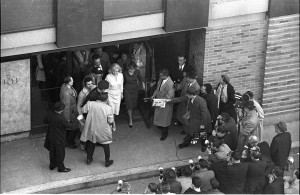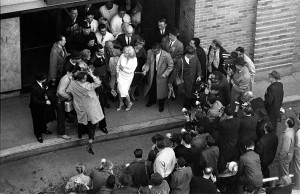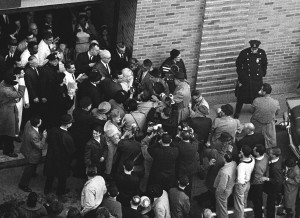MARILYN MONROE
(March 1961)
From the moment I arrived back in New York, Mary and I were never apart (with the exception of my travels away on assignments). In early March, Paris Match had me visit Columbia Presbyterian Hospital in upper Manhattan. Marilyn Monroe was a patient there and no one knew why she had been admitted. Word had gotten out to the Match reporters who were connected to society hawks that Marilyn had only a few weeks earlier been in Payne Whitney Psychiatric Clinic suffering from a nervous breakdown. Could she have had a relapse? Or was there some other medical condition that needed immediate attention? In any case, I was dispatched to Harkness Pavillion, a part of Columbia Presbyterian, to see if I could get a photograph that might tell the story. Short of seeing Marilyn waving from her hospital window, or a sign proclaiming ‘MARILYN MONROE IN HERE’ I was at a loss for picture ideas.
Mary had joined me and as we sat outside the hospital in a borrowed car when I spotted Joe DiMaggio striding up the sidewalk heading for the entrance to the hospital (it was later discovered that it was DiMaggio who had arranged for her to transfer out of Payne Whitney to Columbia Presbyterian). Marilyn had been divorced from DiMaggio for some time and had since married and divorced playwright Arthur Miller. It had been thought that DiMaggio was out of the picture as far as MM was concerned, but there he was, walking quickly up the handicap ramp to the hospital entryway. I jumped out of the car, my Nikon SP hidden under my trench coat, and grabbed for it as I walked to meet him. He was carrying flowers. I shot a few pictures ‘from my hip’ so as to not alert him of my intentions, unfortunately, a few blurred and hurried photos. Joe D entered the building and I followed him.
If only I could get a picture of him hovering over Marilyn in her hospital bed. I trailed him to the elevators and slipped in with him. I smiled and nodded to him. He was, after all, Joe D. As a Bronx-born Yankee fan, I had idolized him growing up. Now we shared the same rarified air of a hospital elevator, both of us heading for Marilyn Monroe’s private room, only one of us knew that. The elevator stopped on the 7th floor. Joe nodded to me and exited. I had pressed 10 but now quickly stopped the doors from closing, paused, then stepped out. He was turning the corner, heading down a hallway. I followed quickly behind him. My camera was at the ready and he turned down a second corridor. When I reached the corner, he was entering a room. That was it! He didn’t leave the door open. I walked down the corridor and passed a nurse who looked me up and down and realized that I probably didn’t belong on that floor. When I arrived at the door, I hesitated. Should I reach over, open the door, snap a picture or two then take off. I tried to time my movements but a voice called out. It was the nurse. “Excuse me, Sir!” she called out. “What do you want here?”
If I had been a veteran Match photographer I would have not only opened the door but gone in and said “Smile.” But I chickened out and began walking down the corridor. I saw a fire stairwell and started down to the ground floor. I rewound what few exposures I made, opened my camera, took out the film and slipped it into my jacket pocket. I replaced the roll with a new one, snapped off a few exposures and as I arrived on the ground floor I opened the door and walked into the arms of the hospital security forces. Two of them; the senior man, a retired NY detective.
They took me to the security office and asked me for the film. I opened my camera took out the unexposed film and handed it to them. They pulled it from the cassette ruining whatever might have been on the roll. Asked if I had another camera, I showed them I had only the one. They let me go. I had saved the blurry photo of Joe DiMaggio on the street.
In the end, there really was only one photograph worth shooting.
Several days later, on March 5th, Paul Slade and I went up to West 168th Street, to Columbia Presbyterian, the day Marilyn was to leave the hospital. Just outside the main entrance, where I had encountered Joe DiMaggio, the large gathering of press with movie cameras and still cameras and radio microphones at the ready, waited impatiently. To say it was anything but a mad house, would be telling a lie. It was a near riot of journalists jockeying for position, and the fuse had been lit. It was difficult for me to discern that all hell would soon break loose and wherever I put myself would probably be a mistake, because it would change in a matter of seconds when MM exited the building.
Paul moved in among the photographers and cameramen and I followed not to enthusiastically. Once in the pack, I looked around for a better angle. On the ground, in front, there was nothing better than being squeezed in among the horde. Every photographer would leave with nearly the same photograph. There would be nothing unique unless…unless…I looked behind me and saw there was a six-story apartment house. If I could just get into one of the third floor apartments facing the hospital…
No time to waste. I told Paul I was going up high. He looked at the building and said, ‘You don’t have time. She’ll be out in a minute.’
I didn’t wait. I ran to the apartment building, pressed several bells until I was buzzed in. then hurried to the elevator. I pressed 3 and when the elevator stopped, I stepped off and walked along the hallway to the apartment I imagined would look down upon the hospital’s front doors, then rang the doorbell.
‘Who is it?’ A Jewish sounding woman’s voice asked.
‘I’m a photographer. I wanna take a picture from your window of the hospital.’
‘Why?’
‘Because Marilyn Monroe is leaving the hospital in a few minutes.’
The locks turned. The door opened. ‘Marilyn Monroe?
‘Yes!’ She let me in and I rushed to the window. The crowd of journalists were still surging and still waiting. MM hadn’t left yet. I opened the living room window and leaned out holding my Nikon F with 105mm lens.
‘You don’t have a pillow I can use by any chance?’ I asked. ‘For my arms…’
She gave me a pillow. I rested it on the sill just as Marilyn, and a whole entourage of press flaks, doctors, nurses, cops, and my favorite security people, stepped from the front doors
into the hungry press corps. The riot I predicted happened as the mass of cameras and microphones closed in around her, suffocating her. Few, if any, of the photographers on the ground shot anything worthwhile of Marilyn’s hospital departure. My vantage point was perfect. It told the whole story. Marilyn—the woman in white—confronted on all sides by people all wanting a piece of her.



Leave a Reply